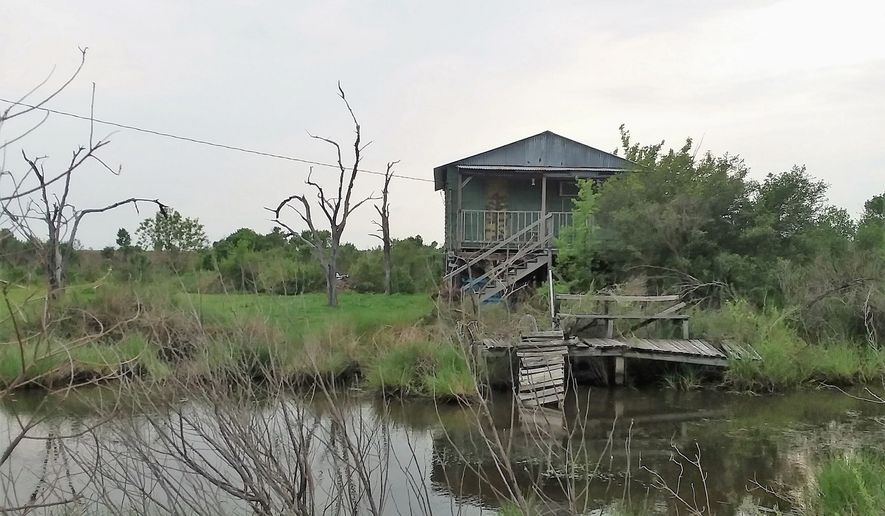ISLE de JEAN CHARLES, La. — Bert Naquin sees no reason to leave her perch 15 feet above the expanse of salt water, which is creeping closer by the day.
“I’ve got the sunrise over here and the sunset over there,” she said as she pointed toward the Gulf of Mexico and the network of bayous feeding it. “But it’s a shame they don’t want to fix the road.”
Ms. Naquin, 62, is a member of roughly 15 families — the number shrinks each year — that still feel at home on this spit of earth sticking into the Gulf of Mexico. Like most of the others, she is a member of the Biloxi-Chitimacha-Choctaw Indian tribe, and they are still surprised by the attention from climate change activists who consider the island Exhibit A for vanishing habitat.
Neither she nor the others on Isle de Jean Charles claim to know much about the scientific theory of climate change. Many of them blame the artificial course of the Mississippi River created by the Army Corps of Engineers for the erosion of their turf.
One school of thought on the island, entrenched on the deck of the Isle de Jean Charles Marina, is that if the Army Corps brings back what it dredges from the Mississippi rather than dumping it into the Gulf, then the land loss problem would be solved.
Whatever the reason, the land is disappearing. What was once a peninsula of 22,000 acres is down to a finger of 320 acres.
Consequently, the state wants the American Indians and the handful of others to move to a community it is building. The project is part of Louisiana’s Coastal Master Plan, set into motion after Hurricanes Katrina and Rita ravaged the coast in 2005. It is bankrolled chiefly by federal taxpayers with a $48.3 million grant in 2016 from the Department of Housing and Urban Development.
Louisiana officials, who spent nearly $12 million on land some 40 miles from Isle de Jean Charles in Terrebonne Parish to house the families, acknowledged last month that they were behind on their timetable. They blamed meticulous planning rather than red tape.
“It’s been the infrastructure design and home design,” Pat Forbes, executive director of Louisiana’s Office of Community Development, told The Washington Times, noting the yin and yang of cosmetics and function. “We don’t want a lot of cookie-cutter same houses, but we do want to reduce maintenance costs over the long term.”
That desire meant consulting with Louisiana State University about wind-resistant clips, elevations and 6-inch-thick walls to help the homes weather Louisiana better than Isle de Jean Charles managed to, Mr. Forbes said.
Nevertheless, the delay is an indication of the rocky path of relocation projects.
“History has led to an ingrained public distrust of relocation or resettlement projects,” the Tulane Institute on Water Resources Law and Policy noted in a 2014 paper. “The history of population dislocation in southeastern Louisiana is generally one of failed government intervention.”
Despite the setbacks on the Isle de Jean Charles, Mr. Forbes predicted that the project would meet its target completion date of September 2021, although officials hope to have many families relocated and settled long before then.
Whatever the timetable, Therese Billiot, 60, has vowed to be among the last leaving her ancestral home. Like Ms. Naquin, Ms. Billiot’s house on the island sports a large “Not for Sale” sign.
The sign stands in front of a rickety bridge that leads to the family property and the house, which is set back about 25 yards from the road. Often flooded, the two-lane road is the only ribbon between Isle de Jean Charles and the mainland.
“One day I’ll probably have to go,” she acknowledged glumly as she sat quilting inside with her mother. Ms. Billiot, 60, moved back to Isle de Jean Charles, where she grew up, some six years ago to care for her mother. Now that Ms. Billiot has retired, neither woman wants to leave.
“They’ve changed the rules,” she said, noting that the state is now allowing residents to keep their land and homes if they leave — they just can’t care for them.
“No repairs over $2,500,” Ms. Naquin said. “They want you to treat your home like a camp.”
A handful of families gave up and moved out last year, leaving the island increasingly dotted with the mostly wooden ruins of campers, homes and bridges.
“There’s still a girl that comes by about once a month to see if we’ve changed our minds,” Ms. Billiot said with a wry smile. “She works for the state. Our answer is always the same. We’re not leaving.”
The unique position these women occupy, in terms of their possible relocation and their American Indian roots, attracts a steady stream of visitors to the forlorn strip. They are bemused by the attention. Ms. Billiot told a recent visitor that she had just welcomed some environmental activists from Washington who were on the island, and Ms. Naquin pointed to her refrigerator, adorned with a Los Angeles Times photo of her on her porch.
Two of her brothers have opted off the island and accepted the state’s terms, said Ms. Naquin, a niece of Albert Naquin, the acknowledged chief of the IDJC Native Americans. Chief Naquin has largely come to endorse the relocation project, although he was upset a year ago when neither he nor the tribe was reportedly consulted on the land purchase.
Those roots run too deep for her to leave her shallow homeland, Ms. Naquin said.
“The Budweiser truck still comes to the landing,” she said of the IDJC Marina, a boat launch and fishing charter business that also happens to be the last watering hole on the strip. “FedEx comes out here, there’s the fire station — so there’s still hope.”
• James Varney can be reached at jvarney@washingtontimes.com.




Please read our comment policy before commenting.